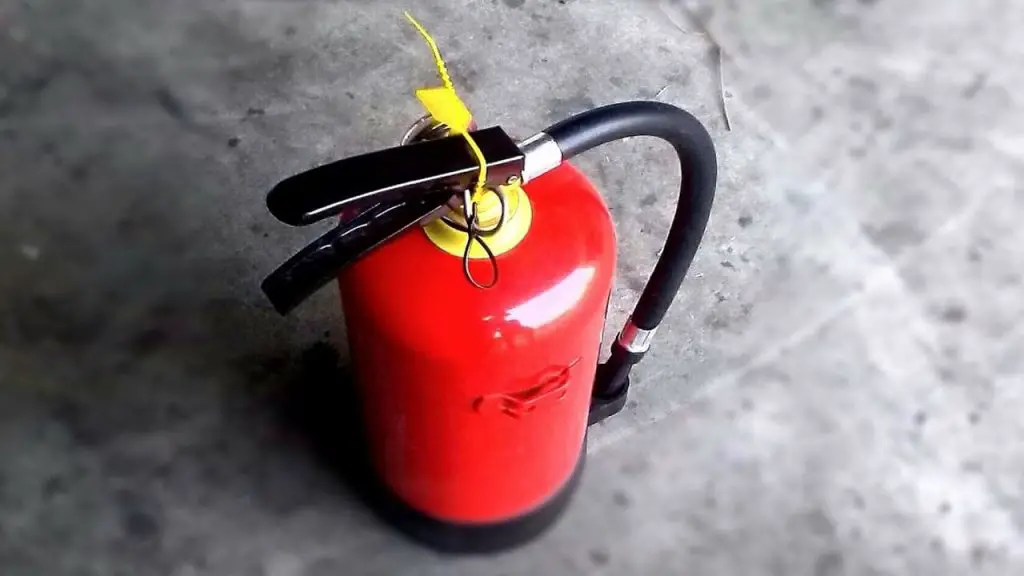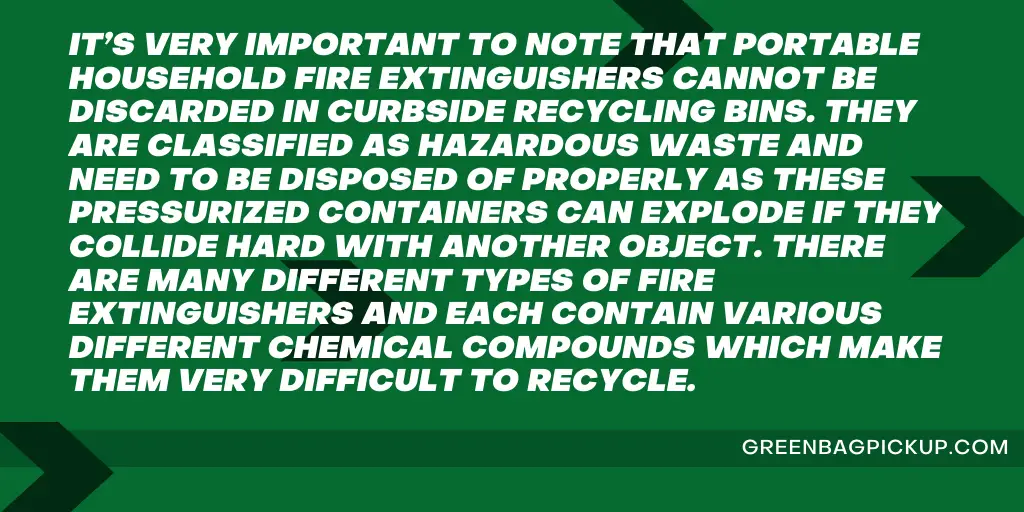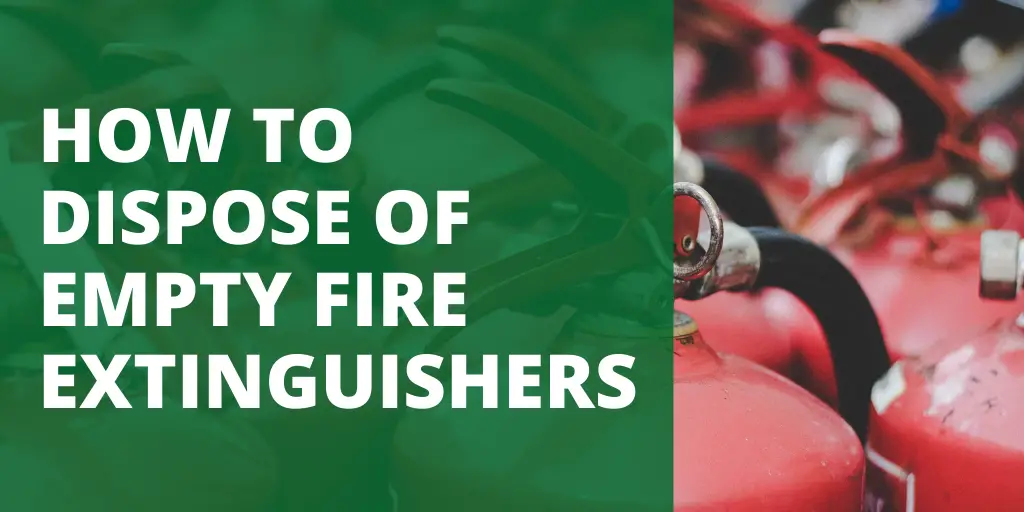You have an empty fire extinguisher and you have no idea what to do with it. Tossing it in the recycling bin just seems wrong and you definitely don’t think you should be disposing of it in the garbage. So, what’s the best solution for disposing of an empty fire extinguisher?
We’re going to take you through exactly how to dispose of empty fire extinguishers, so you’ll know what to do the next time you have one.

Why is Proper Disposal of Empty Fire Extinguishers Important?
Empty fire extinguishers can cause significant damage to the environment and people if not disposed of properly. You cannot throw away empty fire extinguishers in the regular trash because they contain pressurized containers that may explode, causing harm to people or the environment.
Additionally, some fire extinguishers have hazardous materials, such as chemicals, that can cause damage if not disposed of properly. Therefore, proper disposal of empty fire extinguishers is necessary to ensure the safety of people and the environment.
Types of Fire Extinguishers
Different fire extinguishers are used to extinguish fires caused by other materials. Fire extinguishers are classified based on the kind of fire they can put out. Some of the common types of fire extinguishers include:
- Water fire extinguishers
- Carbon dioxide fire extinguishers
- Foam fire extinguishers
- Dry powder fire extinguishers
- Wet chemical fire extinguishers
Each type of fire extinguisher requires a specific method of disposal. For instance, a water fire extinguisher should not be disposed of like a dry powder fire extinguisher. It is essential to understand the type of fire extinguisher you have before disposing of it.
How to Dispose of Empty Fire Extinguishers
The best way to dispose of an empty fire extinguisher depends on the type of extinguisher you have. Here are some general guidelines to follow:
- Check with Local Waste Recycling Centers: Fire extinguishers can be recycled. The first step in disposing of an empty fire extinguisher is to check with your local waste recycling center to see if they accept them. Many recycling centers will carry fire extinguishers and dispose of them properly.
- Contact the Manufacturer: Some fire extinguisher manufacturers have take-back programs that allow you to return the extinguisher for proper disposal. Contact the manufacturer to inquire about their program.
- Contact Local Fire Department: If you need help disposing of your fire extinguisher through a recycling center or the manufacturer, contact your local fire department. They can guide how to dispose of the extinguisher properly.
- Empty the Extinguisher: Ensure it is empty before disposing of your fire extinguisher. You can do this by releasing the pressure in the extinguisher and using the remaining contents. If you need help emptying the fire extinguisher, consult the manufacturer’s instructions.
- Remove the Valve: Once the fire extinguisher is empty, remove the valve from the top. This will make it easier to recycle or dispose of the extinguisher properly.
- Label the Extinguisher: If you recycle or dispose of the fire extinguisher through a waste recycling center or the manufacturer, label it with “empty” or “discharged” to prevent it from being mistakenly used.
Smcfire.org gives their instructions on how to dispose of an empty fire extinguisher:
Discharge the fire extinguisher to empty any remaining contents that might be lingering inside the cylinder. Prior to recycling, the fire extinguisher must be completely empty.
Disconnect the head from the cylinder.
Recycle the head and the cylinder at any drop-off site that accepts ferrous metals, such as steel.
Make Sure You Can’t Reuse It
While your first instinct may be to find a way to dispose of an empty fire extinguisher – after all, it is empty – let’s make sure you can’t recharge it first. Fire extinguishers can certainly be used again if they’re only used once, and can be refilled by a trained professional.
Earth911.com tells us why you might be able to reuse your fire extinguisher before you think of disposing of it for good:
Luckily, your fire extinguisher is made of highly recyclable materials, like aluminum for the tank and steel for the valve. But before we get into recycling, let’s review when you need to recharge your extinguisher.
Loss of pressure: Over time, fire extinguishers lose their pressure. That’s why they have a gauge that shows the ideal pressure. If the pressure is too low, contact your local fire department and ask if it can be recharged. They might be able to recharge it at no cost or refer you to a professional for servicing.
After each use: If you use your extinguisher just once, you need to have it recharged. Some extinguishers can be manually refilled, but without training this can be dangerous.
You should use a trained professional to make sure your extinguisher is safe and gets recharged with the correct extinguishing agent. Your local fire department may be able to refer you to a professional.
Can Fire Extinguishers Be Recycled?
While empty household fire extinguishers can technically be recycled, they can’t just be taken to the curb like the rest of your household recycling. Fire extinguishers can be hazardous for a number of reasons, whether or not they’re empty.
Buschsystems.com explains why fire extinguishers can’t be recycled with the rest of your used items:

Tips for Disposing of Empty Fire Extinguishers Safely
Here are some additional tips to keep in mind when disposing of your empty fire extinguisher:
- Wear protective gear: When emptying a fire extinguisher or removing the valve, wear gloves and eye protection to avoid accidents.
- Do not tamper with the fire extinguisher: Do not attempt to dismantle or puncture the fire extinguisher. This can cause the extinguisher to explode, which can be dangerous.
- Store in a cool, dry place: Store the empty fire extinguisher in a cool, dry place until you can dispose of it properly. Do not store the extinguisher in direct sunlight or a hot environment.
- Follow local regulations: Be sure to follow any local rules or guidelines on the disposal of empty fire extinguishers. Some areas may have specific rules or restrictions on how to dispose of fire extinguishers.
The Bottom Line
Proper disposal of empty fire extinguishers is crucial to protect the environment and people. Follow the guidelines above and consult the manufacturer’s instructions before disposing of your fire extinguisher.
Remember to wear protective gear, check with local waste recycling centers, and contact the manufacturer or fire department for guidance. You can safely and responsibly dispose of your empty fire extinguisher by taking these steps.
Is fire extinguisher powder toxic?
The dry powder in fire extinguishers is generally non-toxic. However, it can cause skin irritation and should be avoided. It is recommended to check the manufacturer’s website or the information on the extinguisher itself to confirm the specific chemicals used.
If the fire extinguisher were to spray toxic chemicals, it would not be licensed for home use.
How do I know if my fire extinguisher is empty?
You can usually tell if a fire extinguisher is empty by checking the pressure gauge or lifting it to see if it feels light. If the indicator is red or the extinguisher feels light, it’s likely empty.
Can a fire extinguisher be refilled?
Yes, you can refill fire extinguishers if they have not expired or been damaged. Refilling should only be done by a certified professional and follow the manufacturer’s guidelines. It is not recommended to refill a disposable fire extinguisher.
Additional Posts:

